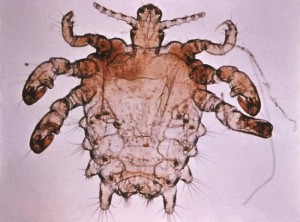Pubic lice: They don’t call them ‘crabs’ for nothing
It doesn’t matter what’s your status in life, crabs can be found on anyone, anywhere.
The pubic louse, Phthirus pubis, is typically found on pubic hair, but can also be found in armpit hair, eyebrows or mustaches and beards. It is strictly a human infection; you cannot get them from animals.

Phthirus pubis, or more commonly known as the pubic or crab louse
Image/CDC
They get the nickname “crabs” from its appearance in the adult or nymph stage. They have six legs with the two front ones having the resemblance of pincher claws.
Pubic lice are tan to grayish white in color.
You may also see the nit stage. These are the lice eggs. They are oval, yellow to white in color and attached to the hair shaft. You may need a magnifying glass to see the details of the louse or nit.
They don’t transmit any infectious disease; however, there may be allergic reaction and redness from the lice saliva. Itching that crabs cause can make a person scratch and secondary bacterial infection is possible.
In young children pubic lice may also be a cause of blepharitis (irritation or infection of the eyelids).
In most cases, pubic lice are transmitted sexually from the pubic hair of one person to another. But lice can be contracted in other ways, too — from infested clothing, towels and bedding.
Pubic lice, nymphs and adults must feed on blood to live. If it falls off the person, it’ll die in a day or two. A common misunderstanding is that pubic lice are spread easily by sitting on a toilet seat. This would be extremely rare because lice cannot live long away from a warm human body and they do not have feet designed to hold onto or walk on smooth surfaces such as toilet seats.
Crabs are diagnosed by finding a louse or a nit in the hair. If someone is diagnosed with crabs, other sexually transmitted infections should be investigated. If a child is diagnosed with pubic lice, sexual abuse should be considered.
How are “crabs” treated?
According to the Centers for Disease Control and Prevention:
A lice-killing lotion containing 1% permethrin or a mousse containing pyrethrins and piperonyl butoxide can be used to treat pubic (“crab”) lice. These products are available over-the-counter without a prescription at a local drug store or pharmacy. These medications are safe and effective when used exactly according to the instructions in the package or on the label.
Lindane shampoo is a prescription medication that can kill lice and lice eggs. However, lindane is not recommended as a first-line therapy. Lindane can be toxic to the brain and other parts of the nervous system; its use should be restricted to patients who have failed treatment with or cannot tolerate other medications that pose less risk. Lindane should not be used to treat premature infants, persons with a seizure disorder, women who are pregnant or breast-feeding, persons who have very irritated skin or sores where the lindane will be applied, infants, children, the elderly, and persons who weigh less than 110 pounds.
The CDC offers the following measures to prevent contracting “crabs”:
- All sexual contacts of the infested person should be examined. All those who are infested should be treated.
- Sexual contact between the infested person(s)s and their sexual partner(s) should be avoided until all have been examined, treated as necessary, and reevaluated to rule out persistent infestation.
- Machine wash and dry clothing worn and bedding used by the infested person in the hot water (at least 130°F) laundry cycle and the high heat drying cycle. Clothing and items that are not washable can be dry-cleaned OR sealed in a plastic bag and stored for 2 weeks.
- Do not share clothing, bedding, and towels used by an infested person.
- Do not use fumigant sprays or fogs; they are not necessary to control pubic (“crab”) lice and can be toxic if inhaled or absorbed through the skin.
When properly and consistently used, condoms decrease the risk of STDs. However, because condoms don’t cover the area with pubic hair, they are not good protection against pubic lice.
For more infectious disease news and information, visit and “like” the Infectious Disease News Facebook page














